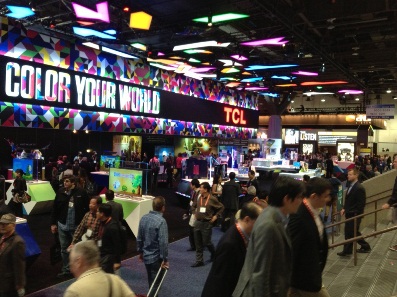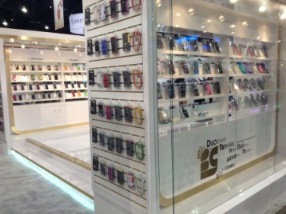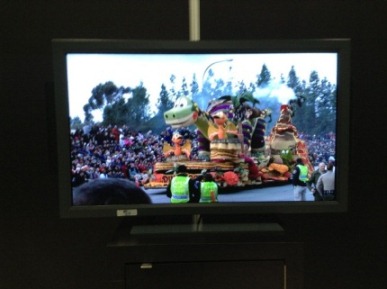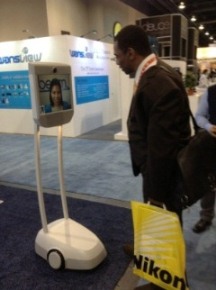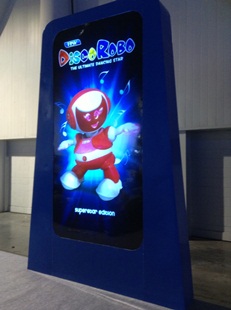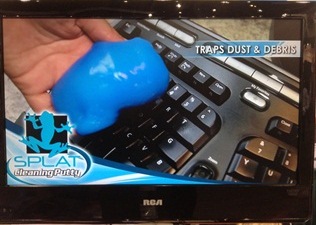The Consumer Electronics Show is now over, tens of thousands of devices have been unplugged, the U.S. power grid has returned to normal, and I have finally begun to decompress. And able to step away, I can now see the madhouse circus zoo in a better perspective.
I love CES, which is strange because I utterly hate crowds, don't like going to malls. But CES is a joy. It's Disneyland for adults. And you have the chance to get a sense of where technology is going and what to expect to see in the marketplace during the coming year.
I noticed something a bit different at CES this year, something that occurs every five years or so. It's that there didn't seem to be a whole lot of innovations at the show, new technology. It was more a case of refinements on existing technology. Make no mistake, what was there was seriously impressive, it's just that it all felt a little status quo. What always seems to be the case that technology moves so fast that sometimes it needs to a breather every five years to catch up.
There was one notable exception. A push towards a new technology that's here. At least from one company. And it could be a game-changer. More on that later.
A few short overview observations before diving in:
You will read little here about TVs, cameras, and Smartphones. There are SO many of them, and even the worst are impressive. Further, the descriptions that companies come up with to differentiate why theirs is The Best are written in tech-geek languages that no human uses or understands. ("This features a state-of-the-art P25ix connector with our proprietary Macombite 48893 technology.")
Nothing here about cases for phones and tablets either. There are lots of cases at CES. Lots and lots and lots and lots and lots of them. Lots. And then lots more. And more. Imagine falling overboard and treading water in the middle of the ocean, except that it's cases. Later in the year, I'll be writing a report about a few cases I requested before coming here. But for now, I'm just getting the jitters thinking about cases.
Also, for years the Central Hall was (and remains) the centerpiece of CES. It's where the Big Guys have their booths. LG, Sony, Panasonic, Samsung, Sanyo and more. And for the first time, I didn't even go into the Central Hall to look at them. The truth is, over the years, I've started to get "sensory overload" by the Central Hall. Booths and displays there are SO massive, with SOOO many people congregating, and SOOOOO many products that you felt like you were getting swallowed by a wormhole. All that, compounded further because these companies don't just have one model, they each have about 30 different versions. Whatever the product. Whatever the company. Eventually, I realized a Great Reality. That for products at this high end, it doesn't matter much what anyone says. You're going to ask your friends, "What TV do you use?" Or you'll go to Best Buy, look at the display, check the prices and say, "Can you give me a deal? I'll take that one."
And so this year, I avoided the Central Hall. Instead, I spent my time in the South and North Halls, which have some of the more interesting products that I think are of more individual interest.
That leads to another point. I'm always asked, "So, what cool things did you see at CES this year??!!" And the expectation is that the coolest are those Whiz Bang products that the Big Guys have with shiny lights and lots of wires. But for me, the "cool things" are the small devices that take things you actually use in your everyday life and make them SO much easier and better. I'll note a few as the article goes along.
That brings up the final observation - something you've probably figured out at this point. This is going to be long. I mean, honestly, long. There's so much at CES, and what people tend to get in reports are a few devices that got heavily promoted. I like to give a sense of the show itself, the small gems and big oddities, and what the tech world may have in store for the coming year that reads might use. So...really...this is going to be long. No whining. You've been warned. If you don't want "long," stop now. Seriously. Run for the exits. But if you want to come on the ride, there's the cheese deep, pull up a comfortable chair and sit back. Yes, I know this will be longer than it should be - but just think of it as the tech article equivalent of the first The Hobbit movie. And now, we're off to see the Techno Whiz. There and back again...
One of the areas I was particularly curious in seeing was Windows 8. Interestingly, Microsoft got a lot of attention earlier in the year when they announced they wouldn't have a presence at CES. Introducing a new operating system might have seemed a god time to be there. Whatever.
The little I've used Windows 8, I've been generally impressed. One of the immediate hurdles though is that it's ideally a touch-based operating system, but most computers in current use can't take advantage of the touch feature. However, several devices now overcoming that. Targus Touch Pen for Windows 8 and E-Fun's aPen Touch 8 license a product from Yifang Digital which attaches to your monitor and connects to a USB port. Your screen will then become touch-capable (though you have to use the included "touch pen.") Both near-identical devices retail for $100.
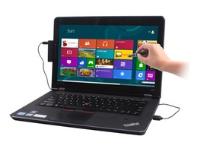
Logitech has a fascinating twist on this. TheT650 Windows 8 Touchpad is a standalone pad with a glass top to feel like a monitor. A USB receiver connects it to your computer, and you can then run your finger across the pad exactly as you would if it was your touch screen monitor. It retails for $80. They also make a series of mouse devices that do something similar. The pad sounds much more interesting to me, and I thought it was one of the Cool Things I saw at CES, though a fellow-tech writer friend said he's used both, and his preference was the mouse. Which would make that pretty cool.
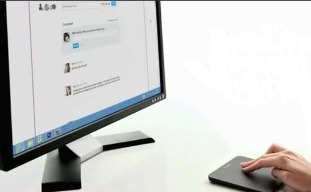
From a slightly different angle, Parallels Desktop 8 for Mac makes an absolutely remarkable-seeming product that's been around for a while. ("Seeming," because I've only seen it demo'ed). I came across Parallels at the IFA Berlin tech trade show this year and wrote about in detail there. The short version is that the software lets you run Windows (even Windows 8) on a Mac computer, all without rebooting. In fact, you can run any number of operating systems in separate windows.
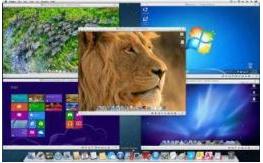
As for Windows 8 itself and the new world of its devices, I personally find the Windows 8 tablet a fascinating addition to the field and quite valuable, because you can actually use them for work. Unlike the wildly-popular iPad and popular Android tablets, those are "content" devices largely for email, Internet browsing, reading books and watching movies. Windows 8 tablet are "productivity" devices that also let you work . The basic Surface tablet, for instance, includes Microsoft Office on it. Plus, all the Windows 8 tablets include a USB port, so you can plug in peripherals, like a printer.
(A very quick word about Windows 8 and tablets. The operating system comes in two core versions. Windows RT is a tablet-only system that runs apps, just the same as an iPad or Android tablet does - though as noted, Microsoft Office is included. Windows 8 Pro is exactly the same - but it also allows installing all standard Windows programs.)
I'm in the early stages of testing the Dell XPS 12, which is a "convertible," in that it's a notebook that can convert into a tablet by swiveling the screen on an axis. Thus far, I'm impressed. It's thin, though not as thin as a pure tablet. It's also heavier, about 3 pounds, but is comfortably light to carry.
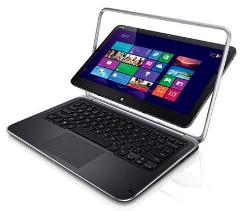
Toshiba also has the convertible Satellite U925t. Its screen folds flat and then slides in, which is what turns the notebook into a tablet. It looks and feels extremely well-made, like most Toshiba's I've come across, and is reasonably thin. The one early quibble is that it's almost four pounds.

Samsung has released their Windows 8 tablets, and the ones I played around with look very sleek, are thin, light and were a pleasure to use. And ASUS, Lenovo, and Acer are in the mix, too, among many others. And coming soon, with much anticipation, is Microsoft's Surface Pro, because it will run the full-featured Pro version of Windows 8.
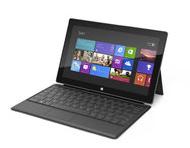
And of course there's the granddaddy of tablets, the iPad. Apple wasn't present at CES either, and never is, though accessories overflow. Too many to reference, but a few are eye-catching. One came from a new company out of China (though not new there, where it's the top seller of Apple accessories), GGMM, that's trying to break into the U.S. market. Their wide range of products were notably well-designed. The Intelli Type is a multi-functional device that attaches a keyboard, screen cover, support stand and Lithium battery to an iPad into a compact unit - yet the parts can also be separated, for instance if you prefer to type at a distance from the iPad itself. It's wonderfully designed, very well-made and practical, but know that it's a on the heavy side (in part, I assume, because of the added battery for longer life). It retails for $70.
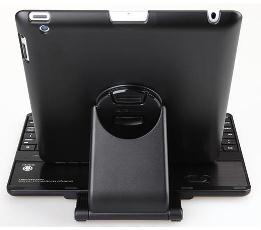
In the world of computers, Viewsonic was showing its PC-less Desktop VSD240. This is a beautifully-designed system that has everything built into a large touch-screen. It retails for $499 and is due in April. The one oddity is that it runs Android's Jelly Bean operating system only. There's no Windows 8 version. Their representative explain why not, but it seemed a limiting decision to me for such an otherwise impressive product.
A screen of a different sort comes for a small company with the tongue-twisting name, QP Optoelectronics, who will be coming out with their Cloudview Pico projector. Pico projectors are handheld devices, about the size of a fat iPhone, that allow you to beam images from anything like a computer or Smartphone onto a wall. What was impressive about the Cloudview is that usually with Pico projectors you have to be far away to get a large image, and "large" usually isn't very. The Cloudview, though, can be close to the wall, and provide full-size images. In fact, you can get an image as large as 50-inches from only a couple feet away. It's due for release in April, and the retail price is $249.
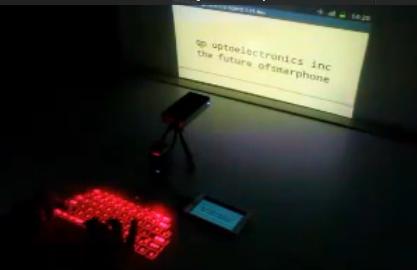
And when it comes to viewing images, that finally brings us to that aforementioned Big Technology Advance that was at CES this year. It comes from a tiny company, Stream TV Networks, out of Philadelphia, who make a product called Ultra-D. And Ultra-D is their technology for 3D TV...without glasses.
I came across Stream TV Networks about four years ago totally by accident, when they were pushing their brand of tablets. Offhandedly they asked if I wanted to see a private demo of their glasses-free 3D TV. They were so apologetic that it was the early stages, yet already it was clearly leaps and bounds ahead of all the Big Guys. Really impressive. They've only gotten better, and now they're nearing "Game-changing" Land. In fact, they're about to start mass-producing sets in just three months tops. (And that's not even the game-changing part.)
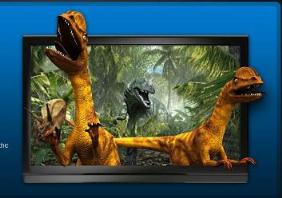
I've written about both the company and 3D TV in general at length over the years, so I won't go into great detail here, but a cursory overview is required. (The rest of the discussion of what's new from Stream TV Networks, though, will be lengthy, so don't worry. I haven't forgotten how to be long-winded...)
The image from 3D TV with glasses is amazing. But it's not the way people watch television. When watching TV, you read books, work, talk to others in the room, and wander around. Glasses impede that. And if you have a friends over for the evening, you need glasses for all of them. I think these are among the reasons that 3D TV (with glasses) hasn't caught on yet, despite a huge push.
Glasses-free 3D eliminates all those issues. The 3D image is not as eye-popping as with glasses, but a) it's quite good (more on that in a moment), and b) it's usable, period. That point "B" is the most critical one.
With glasses-free 3D, there's always been an issue with viewing angles, that you have to sit in specific areas. I don't find that a problem at all with the Ultra-D technology. I wandered around the room, and the 3D image showed everywhere. It was more pronounced viewed straight on, but "straight on" was a big area. And it still could be seen reasonably well off to the side.
Another big question with 3D (even with glasses) is content. Little of it exists, except rental movies. But Ultra-D resolves that, as well. It converts in real time any TV content to 3D. Further, some people don't want to watch everything in 3D. (Do you really need to see the news popping out at you?) Well, the Ultra-D technology deals with that, too - you can easily adjust the "pop" for whatever you want. More clarity and less pop, or big 3D pop, but a less sharp image.
No photograph of 3D TV will look good, but still, here's a picture I took of a TV using Ultra-D that was showing video of the Rose Bowl Parade. At the very least, you can see that there is content for 3D TV.
By the way, I still haven't even gotten to the "game-changing" part. Hold on a bit.
A few months back I was at a 3D Symposium in Los Angeles. The head of Stream TV Networks, Mathu Rajan, was on a panel with other 3D TV experts, all of them glasses-3D people. At one point, a fellow politely, but a bit dismissively acknowledged begrudgingly that glasses-free 3D TV was interesting but "five years away." Mr. Rajan sat politely and said nothing. Later, he said that it took a lot of self-control not to announce that his company already had manufacturing deals and were about to start mass-producing sets for general sale to the public. (As I noted about, it's now only two or three months away.)
The company plans to license their Ultra-D technology for other manufacturers to use in their sets. At the moment, a giant Chinese company, Hisense, has a license deal, as does Pegatron - you may not heard of Pegatron, but they make something called the iPhone.
Throughout CES, representatives from almost all the Big Boys were camping out at Stream TV Network's booth, as did movie studio reps (to talk about streaming movies in glasses-free 3D TV), ESPN and more. One company hung around so long they were almost charged rent. Another representative was overheard saying, "How can we compete with this??", since Ultra-D is so far advanced over most everyone else. That's where the licensing comes in.
The image was crisp and impressive. Not as good as the best 3D TV with glasses, but very good...and (critically) 100% usable.
And now, we finally come to the game-changing part.
There is a new standard coming that goes by a lot of names, but 4K is the most common. It's a new, incredibly-high resolution. You've probably heard of 1080p. This is 2160p - that's the resolution of the display. 4K is the content. The concepts overlap, but aren't the same. We'll call it 4K for the sake of simplicity. The resolution of 4K is jaw-dropping otherworldly. The problem is that there's no content for it yet. (Think of it as if you'd invented the world's great DVD player - but DVD disks hadn't been invented yet.) So, all these sets are being developed that can display the stunning 4K resolution, but have absolutely nothing to show on it.
Except Ultra-D can. The technology can convert any regular TV content to 4K...in real time! Hisense, for instance, is manufacturing 4K glasses-free 3D TV sets that can display anything. I saw them in action and...well, words can't describe. I'll try, but it won't do justice. With the sets adjusted for little "pop," the clarity grabbed you and almost forced you to stop and watch, with your jaw dropped. And when changed for greater pop, the image was still breathtakingly clear, but you also couldn't believe you were seeing such impressive 3D on a flat television without glasses. (I kept scratching my head, wondering how is this possible??) How good was it? Let's put it this way, after watching the clarity of 4K, when I went wandering away and saw other regular monitors, my eyes were almost bothered that it was so ordinary.
So, what about price? The company hasn't released any information, but from hints and ranges and off-handed comments, I get the sense that these will actually be sold seriously for the consumer market. It depends on the screen size, and the 4K sets will only be for well-off techno-geeks at first, but even those will be in sight. By way of comparison, a "regular" glasses-free 3D TV from Toshiba that I saw at IFA Berlin this past fall was mentioned at $15,000. The high-end Ultra-D 4K 3D TV is going to be much less than that. And the standard-resolution glasses-free 3D TV sets, those will be significantly less.
It's really game-changing stuff. And the company has further plans for the technology in other venues. To be clear, 3D isn't for everyone. Whether with glasses, in a movie theater, on a TV or wherever, some people just don't like it. But a great many do, and it's a technology that's here. For the first time in the home, it appears that glasses-free 3D TV works.
Okay, that's long-enough to keep you sitting at one time. We'll have an intermission here, and let you take a bathroom break. We'll be here when you get back...
Okay, did you get to stretch your legs? Good, let's continue.
I'll just finish up quickly with one more TV-related item. Logitech makes a wide-range of excellent remote controls. Their Harmony One offers some nice touch capability, but they've now upgraded that to the beautifully-designed, sleek Harmony Touch which also includes swipe commands. It costs more than a very basic remote, of course, though seems to offer a lot of conveniences, if that's more important to you.
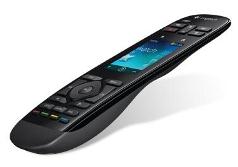
(Side note: it's worth noting that I'm not addressing the combination of TV and the Internet here. Ever since the last WGA strike, when the international conglomerates insisted that the Internet was too young and they "didn't know" if there was a financial future in it, I've noted each year at CES how deeply the two fields have blended into one, with TV sets allowing all manner of vibrant Internet connectivity, and a computer becoming the equivalent of a television. But now the two are SO mature and SO deeply developed it's almost not worth delving into. The point here though isn't how that "distant future" is overwhelmingly here today. The point is that for it to be so rich today - and yes, rich in more ways than one - it had to have been in development for years before the last strike. So, the larger point is that these international conglomerates were lying, and knew they were lying. Shocking, yes, I know. Just a point to keep in mind when the next contract rolls around, and they say they're still studying the Internet...)
Of course, with all this electronics, you somehow have to power the suckers. For reasons I can't explain, I like power devices, particularly portable power. The best I can figure is that the best of these have elegant design and impressive multi-function usage.
One of the most intriguing, and another of my Cool Thing award winner is Energizer's Cup Inverter. This is a power adapter that converts the DC power of your car's engine into AC that you can use for any of your devices, even those that require a basic wall socket. A cord plugs into your cigarette lighter, and the device itself has basic USB ports...but also a "wall plug" built in. Most clever of all, it's designed to fit in your car's cup holder. The company rep said that sales skyrocketed during Hurricane Sandy when people lost power in their homes. But they could use the power from their car and this inverter to plug in their important home devices. Depending on your power needs, it comes either in 120 watts (which should suffice most standard needs) or 180 watts, for power-hungry devices.
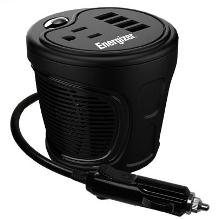
The iWalk company has a series of interesting portable chargers. What most caught my eye was their Extreme 10000, a very-surprisingly small and light device for a charger that holds a massive 10,000 mAh (milli-ampere), enough to charge an iPhone six freaking times. Additionally, it has two USB ports, a micro-USB, and can even turn into a flashlight.
One of my favorite "portable power" companies is the inventive myCharge, whose range of chargers each serve unique purposes, not just larger capacities of basically the same device. Some are road warriors for camping, some have built-in plugs, some offer especially-small portability, and some provide power in a phone case, and so on. They all deserve at least a look. My personal favorite though is the new Hub line, which is basically a smaller version of last year's Peak series. This is a highly portable device with built-in plugs for an iPhone, micro-USB and even wall-charger prongs! So, you never need to carry any external cords. Its retail price ranges from $80-$130, depending on capacity, up to a large 9000 mAh. (About six iPhone charges.) It's not available yet, but that's a good thing - because its iPhone plug will feature the new Lightning adapter for Apple devices.

The iBattz Mojo Refuel battery case for iPhones has a unique twist. At first glance, it looks like any standard battery case for an iPhone, providing power when the phone is inserted into the protective case. But this has a removable battery, an external charger and spare battery. So, you can keep a second battery charged and when the current battery in the case uses up its charge, pop it out and just replace it with the new battery. No down time ever. It retails for $89
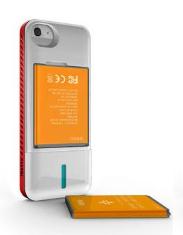
There's one particular power option that's been around for a few years but seemed to be getting a few more vendors this year, and that's wireless charging. This is where devices with proprietary technology built in simply have to lay on a charging pad. No cords needed. Increasing presence though it has, I still find it an uninteresting technology. Who knows, maybe it'll catch on, and I'll be totally wrong.
But another wireless charging technology that I do like is solar. The fine Goal Zero company is loaded with solar options, and one of their newest is the Switch 8 solar recharging kit. It's a tiny unit, smaller than a cigar, that charges via a foldable solar panel. (You can also charge with a USB cord, if sun isn't an option.) It retails for $120. Oddly, one of my favorite things about it isn't the fine charging capability, but a very bright flashlight accessory with a long, snaking arm
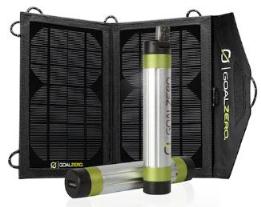
Ascent Solar had a few nice products, like its Surfr Solar battery case, providing emergency solar power for your iPhone, or Galaxy S3. However, my favorite of their products was perhaps the most basic, a portable solar panel, the Kickr IV, which was almost hilariously thin and light, made of a thoroughly flexible rubber.
(As long as we're on green energy, I should also mention the eco Alkaline battery company, which makes "eco responsible" carbon neutral products that are landfill safe. They've recently gotten certified by several green councils.)
Now that you have your portable devices, and the portable power to charge them, you might want to have the ability to playback your music or movies with a portable speaker option that provides far better sound than devices have. And this is an interesting area that keeps making solid refinements.
My favorite may still be a small company I came across four years ago that keeps being creative, X-Mini. (C/NET even discovered them finally and made their core product, the X-Mini II, a Holiday Gift selection a year ago.) They make tiny speakers about the size of a golf ball with booming sound and extremely good clarity. (It "untwists" to allow for even richer sound.) Some other companies may have better portable sound, and some might even be smaller. But I haven't come across anyone who combines the two, sound and size. Their range of products is impressive, and they are releasing two news ones. The Uno has an improved high-end ceramic driver, longer 20-hour battery life, and a weighted bottom for stability. It retails for $40. The Max is a two-unit stereo system (with the same, new ceramic driver) that can also be separated and used as a single, smaller mono speaker. Its retail price is $60.
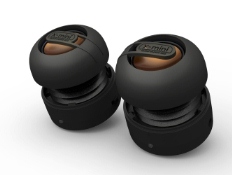
The NYNE NB-200 Bluetooth speaker stands out for coming with bicycle clasps, so you can easily attach the speaker to handle bars of a bike, though connecting it to a stroller seemed more interesting to me. It struck me as a bit larger than I'd personally prefer, but the representative was pretty insistent that it's the perfect size. It also has a built-in mic for hands-free calling, and retails for $100.
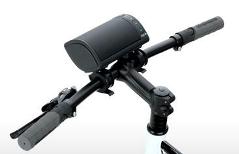
I was particularly impressed by the Noise Hush i7 Active Noise Cancelling Headphones. They claim "near absolute silence," but lots of claims are made at CES. these, however, in the booming noise of the show floor - and with the simulation of an airplane roar piped in - were...well, nearly silent. But what stood out was that, while other seriously high-end headphones also offer similar strong noise cancellation, these were only $130. They're scheduled to be available in February.
Of course, these days, portable doesn't mean merely something for use on the road, since with the huge growth of home office, a great deal of portability is a way to extend the home, and the office there. There was a mountain of home accessories, but a few caught my interest.
When I ran into xPrintServer last year, they were just starting out and largely for corporate needs. Now, they're "mature" and have a home edition - and make the Cool Things list. This is a product that seemingly with great simplicity helps resolve a major issue for iPad/iPhone users - the near-impossibility to print. Plug the small xPrintServer into a router (or Ethernet) and your printer into the device and...well, that's basically it. Then, just use the "Action" arrow on your iPad/iPhone, and print. It retails for $100. And needs a name change.
A great many very small, portable scanners have been released during the past year, largely focused on managing your receipts, business cards, documents, and such, like the Doxie and IRIScan line. Joining the fray is the Neat company, which has a more full-bodied model (NeatDesk), and its highly-portable unit, NeatReceipts, which is about the size of that cardboard roller inside kitchen towels. Small though it is, the heart of the product seems to be its software which recognizes the kind of data it's just scanned and organizes it into forms for easy retrieval, from which you can run reports. For a monthly charge, you can sync the data to the cloud. NeatReceipts retails for $199.
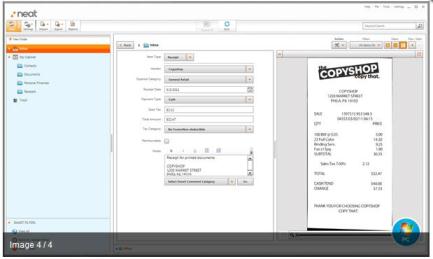
Kingston has a USB Flash drive with an absolutely stunning capacity, the HyperX Predator. These days, 64 GB is huge. This one is -- are you ready -- 1 terabyte! They also have one that's 500 GB. Both use Flash memory, so they're crushingly fast. They're also bulkier than most Flash drives... and they're also both absolutely take-away-your-breath expensive. The 500 GB one is -- are you ready -- $1,750. It's very new, so the price should come down a lot soon. But still, even if it drops to half price, it's clearly not intended for the general consumer market, but those with specific needs, like gamers, as much for that teeth-chattering speed as for capacity. (The terabyte model hasn't been released yet.) Yes, I know the cost is bizarre, but seeing a terabyte Flash drive is just too remarkable, and worth mentioning.
Somewhat related to this, Seagate was showing its external Slim Portable Drive. And slim it is. The smallest I've seen, easily fitting lightly into a shirt pocket. And it too is 500 GB, like the Kingston above, though it has a mechanical drive, not Flash, so it can't remotely compete with speed. But then, it retails for $120. (By the way, as a USB 3.0 device, it should still be speedy by external drive standards, if you have USB 3.0 compatibility.)
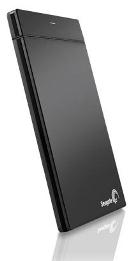
The afore-mentioned GGMM has another well-designed device, ostensibly for the iPad, but it would seem to work for any tablet - but I include it here because it's multi-functional and also serves as a work lamp for your desk. It's the iLight, a stand that holds a tablet as convenient viewing angles - and has a light underneath. But remove the tablet, and the light can crane up on its neck to double as a stand-alone lamp. Very portable, it retails for $60.
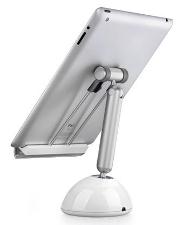
One other home accessory worth noting, that has nothing to do with a home office, but is truly a home-related device. I thought it was quite clever and useful. The Zimri TPMS, a woefully-named product, through no fault of their own. (That "PMS" part is an industry standard name. Tire Pressure Monitoring System.) The name aside, you lock the sensor on a tire lug, and plug the other part into the cigarette lighter. That's all. It will then let you know your tire pressure, if you have a slow leak - or fast one, your tire's temperature and more. Very handy and potentially very helpful.
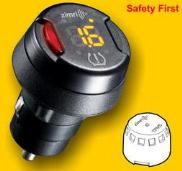
By the way, we're coming to the end reasonably soon. So, have courage, ye of little faith.
Of course, perhaps the lifeblood of any home is the telephone. As mentioned above, the world of Smartphones at CES is far too massive to dive into here, but several phone-ish products leapt out and demanded attention.
To start with, FreedomPop offers an absolutely fascinating family of devices for giving you free (yes, free) 4G capability, on any device, even an iPod touch. I think. You'll have to forgive me here -- I spoke with the president of the company, and he was wonderfully enthusiastic about his product and described everything in loving detail, but his skills at creating a great product and running a company with exuberance do not translate to doing PR - as I told him, repeatedly. He laughed, acknowledged his limitation in that area, and kept trying again. So, I can't swear I got everything clear here. So, bear with me. Basically, the products connect to your iPod and create a hot spot. From that point on, you can have a 4G connection. You get 500 MB of data streaming/downloads for free a month. Anything more than that, you pay. Most of the standalone devices are "free," sort of. You make a deposit (between $49 and $99 depending on the device) -- and if you ever want to return it, you get your deposit back. The one exception is the Freedom Sleeve Rocket, which costs a flat $99. That's because rather than a standalone unit, it's specifically designed as an iPod touch case. Honestly, I probably have some details wrong here, or left out. For instance, it may also work with other Apple devices, allowing you to stream without using your own 4G. Sorry about this, but I know I'm at least close. Check out their website to get the more totally accurate details.
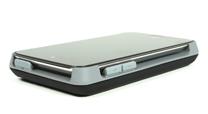
UrbanHello (yes, that's their name) has a CES Innovations design winner with their "Home Phone." (Seriously, now, after coming up with "UrbanHello" as their company name, the best they could come up with for the product was "Home Phone"?) This is a Jetsons-looking design that works as a 360-degree phone, basically a hands-free speaker-phone but one with more directed capability and HD audio.
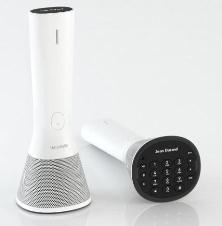
Easily the strangest and most fascinating "phone" was the Beam from Suitable Technologies. Basically this is a video phone on wheels that runs by remote control, giving companies a video presence at events that a person can't attend. Or if you have dozens of these, that let you be in numerous places at once. A person at the home base controls where the Beam rolls around, and that person can talk with whoever wants to converse with a traveling AV panel. Bizarre, but it worked wonderfully. Imagine now the home version where parents can follow their kids everywhere...
Related to phones, Libon offers an interesting app for the iPhone. It's free and lets you create personal answering messages for different people, linking the messages to specific incoming phone numbers. It also converts the incoming message to text, so you can see what the message is about before listening. And if you hit "reply" to call back -- and if the other person is on the Libon network - the call will connect over VOiP, and the call will be free. There are additional features on the premium version, which sells for $2.99 a month.
Health-related products have always had a presence at CES, but now they seem to have overflowed from random pockets and grown to an industry large enough to not only have serious benefits for health care professionals but head-scratching devices, as well, always the sign of tech industry growth...
On the high end, my favorite may have been Moneual's SCS (Smart-Care System) for Hearing Impaired Persons, a CES Best of Innovation honoree. Looking simply like a wristwatch, it recognizes a variety of sounds and voices and discretely sends information to the display.
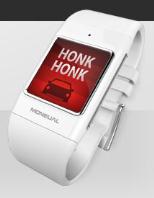
There was also the Fitbug treadmill and app that reported a wide range of data. The WiThings Smart Activity Tracker monitored your heart rate and activity level, also with an iPhone app. NeuroSky, whose truly ugly headsets (that include floppy animal ears that I guess are supposed to be adorable), has a line of products with biosensors that let you monitor your brainwave, how you relate to music, and more, including brain training games. (I could only wonder if one of those games trained your brain not to wear floppy animal ears in public.) The OSIM UDivine "massage chair and phone" (that let you download music to fit your mood). And the venerable, smokeless (and without nicotine) e-Cigarette company now finally has introduced e-cigars.

In the end (yes, "end" - o huzzah, it's really near now), some of these odder products fit right in perfectly at CES, where the wondrous always crosses paths with the truly weird, as in "What were they thinking??!" And so we conclude with two of my favorites.
The Tosy DiscoRobo Ultimate Dancing Star was one that just grabbed your attention. I mean, what kid wouldn't want to rip open their present and joyously find their own DiscoRobo to dance with?!
And finally, if for no other reason than its name, Splat ElectroClean putty. This is a big glob of blue silly putty that gets press onto your gear and apparently soaks in all the gunk. The truth is, maybe it works great. But you just have to love a big glob of blue putty called Spat at the Consumer Electronics Show.
And with that splat, we turn off the lights at this year's Consumer Electronics Show.
*
To read more from Robert J. Elisberg on all manner of things, please visit Elisberg Industries.

